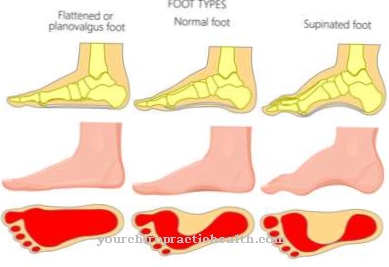The catatons Schizophrenia is one of the different forms of schizophrenia. This leads to psychomotor disorders.
What is catatonic schizophrenia?

© TeamDaf - stock.adobe.com
Under one catatonic schizophrenia a rare type of schizophrenia is understood. In this variant, those affected suffer from psychomotor disorders. Typical manifestations are disorders of posture and movement sequences. But other symptoms of schizophrenia also show up.
The first description of catatonic schizophrenia was in 1874 by the German psychiatrist Karl Ludwig Kahlbaum (1828-1899). In later years the neurologist Karl Leonhard (1904-1988) carried out more detailed investigations into the disease. Nowadays, catatonic schizophrenia is only diagnosed in rare cases.
causes
As with schizophrenia in general, the causes of the catatonic form are still unclear. Doctors suspect that genetic, psychodynamic and environmental influences play a role in their outbreak and influence one another. The mental illness arises from a paranoid form.
The Wernicke-Kleist-Leonhard School of Psychopathology regards catatonic schizophrenia as a heterogeneous group of diseases, just like all other forms of schizophrenia. Karl Leonhard took the view of genetic triggers for the subform of periodic catatonia, which runs in phases. As a rule, schizophrenic illnesses only show up after puberty. In around two percent of all those affected, however, they already appear in childhood.
Symptoms, ailments & signs
Motor disorders are a typical feature of catatonic schizophrenia. These are noticeable through movements of the arms, hands and legs that appear strange. Stereotypical movement patterns or strange postures are also possible, which can last for hours. Patients enter a completely rigid state, which is accompanied by hallucinations or delusions. Most patients can no longer be addressed in this condition. Sometimes the state of rigidity turns abruptly into a violent state of excitement. In the worst case, the sick people even carry out physical attacks on other people.
It is not uncommon for other typical symptoms of schizophrenia to occur. These can include thinking disorders, hearing voices, and fears. There are a number of other possible side effects of catatonic schizophrenia such as automatic command, persistence, negativism, mute (mutism), catalepsy, echolalia, proskinesis, ambition and mannerisms. In particular, the negativism and the automatic command are seen as typical of the catatonic schizophrenia.
While the patient carries out every instruction demanded of him without resistance in the case of automatic command, the opposite is the case with negativism. If the rigidity (stupor) occurs together with fever, it is a malignant, pernicious or febrile catatonia. In earlier times this form of the disease was often fatal.
Thanks to modern treatment methods and drugs, however, there are very few deaths from them these days. Since the patient's body temperature increases in most cases during catatonic schizophrenia, a clinical measurement is essential. The same goes for the CK value. An increase in both parameters is to be feared, which must be treated.
Diagnosis & course of disease
Catatonic schizophrenia is diagnosed based on the typical symptoms. The patient must suffer from catatonia (slackness), catalepsy (remaining in a rigid posture) and flexibilitis cerea (waxy flexibility). Basically, if you suspect schizophrenia, you should go to a specialist or a specialist clinic. Some therapy centers specialize in the early detection and treatment of catatonic schizophrenia.
The doctor makes the diagnosis after detailed discussions with the patient, following strictly defined criteria. Special questionnaires are also used in Germany. To confirm the diagnosis, bizarre postures, hallucinations, or delusions must occur for at least a month.
The differential diagnosis also plays an important role. The doctor rules out any other causes that could be responsible for the occurrence of the symptoms. These include neurological diseases, brain tumors and the misuse of medicines or drugs. For this reason, if catatonic schizophrenia is suspected, various neurological and physical examinations are carried out.
The course of catatonic schizophrenia can vary greatly from person to person. For this reason, it is not possible to make a general forecast. For most people, however, symptoms tend to decrease over time. In principle, all forms of schizophrenia require lifelong therapy.
Complications
This type of schizophrenia mainly leads to motor and psychological disorders in the patient. These have a very negative effect on the life and everyday life of the person affected and can significantly reduce the quality of life. Those affected primarily suffer from severe thought disorders and perceptual disorders. Hallucinations are also not uncommon.
Likewise, patients have a very negative attitude towards different things and people. A strong fever occurs, which is accompanied by a state of rigidity. In the worst case, this can lead to patient death. It can also lead to slight aggression or irritability of the patient.
In many cases, treatment in a closed clinic is therefore necessary if the patient poses a danger to himself or to other people. The person affected can also be dependent on the help of other people in everyday life. In many cases, taking medication leads to side effects, such as tiredness or fatigue; not every treatment leads to a positive course of the disease.
When should you go to the doctor?
Catatonic schizophrenia is a serious health condition that must be treated by medically trained specialists and looked after around the clock. If people suffer from delusions and hallucinations, they need a doctor. If catalepsy or catatonia occurs, a doctor must be alerted as soon as possible. Muscle stiffness all over the body is a warning that should be acted upon immediately. Disorders and abnormalities in behavior and personality must be assessed by a specialist. In the case of catatonic schizophrenia, the person affected is unable to go about their everyday lives independently.
Sudden attacks on other people, physical fights and an uncontrolled demeanor should be presented to a doctor. If the reaction to instructions is basically the opposite, there is a pathological suspicion that must be investigated. If you have paranoia or a strong denial towards everyone, a doctor should be contacted. If there is echolalia or mannerisms, a doctor must be consulted. The patient is to be placed in a psychiatric ward so that he can be adequately cared for and does not pose any danger to himself or to others. Since there is often a lack of insight into the disease, a public health officer is required in severe cases, who assesses the patient's state of health and takes further measures.
Therapy & Treatment
To treat catatonic schizophrenia effectively, the patient is usually given drugs such as benzodiazepines. With these drugs, like lorazepram, a breakthrough in catalepsy can often be achieved. Typical anxiety states can also be weakened by the preparations. As with the other types of schizophrenia, neuroleptics are also used in catatonic schizophrenia.
It is also useful to give mood stabilizers. These primarily include lithium, olanzapine, carbamazepine, valproic acid, and lamotrigine. If the treatment with benzodiazepines does not lead to the desired success, therapy with amantadine, which is one of the NMDA receptors, and dopamine agonists are alternatively possible.
In some cases, special electroconvulsive therapy (ECT) is used to treat catatonia. It has the advantage of being effective and quick to act. It is carried out if the benzodiazepine therapy is unsuccessful. If the state of rigidity lasts for a long time, physiotherapy may be useful.
You can find your medication here
➔ Medicines to calm down and strengthen nervesOutlook & forecast
Catatonic schizophrenia has an unfavorable prognosis. It is a psychosomatic illness that is associated with numerous serious complaints. Without optimal and adequate medical care, there is a risk to oneself and the life of others.
Sick people experience intense states of excitement. In these there are often assaults and attacks on other people.Treatment is therefore imperative and, thanks to modern options, increasingly leads to improved results. The cure of catatonic schizophrenia is still less the goal of therapy. The focus of psychotherapeutic and drug treatment lies in the alleviation of existing symptoms and the reduction of aggressive behavioral tendencies. At the same time, fears and delusions should be reduced. These often lead to situations of excessive demands on the environment and those affected. The overall quality of life should be improved through the interaction of various therapeutic approaches so that interaction with other people is possible.
A stable social environment is essential to improve the prognosis. Despite any problems, relatives should be aware of this. A clinical stay with the patient is still necessary. Coping with everyday life cannot take place without daily support. In addition, there is an increased risk of side effects with this disease. These can be physical or psychological in nature.
prevention
Since the causes of catatonic schizophrenia are largely unknown and genetic triggers are suspected, no effective preventive measures can be taken against the mental illness.
Aftercare
Catatonic schizophrenia is treated as a psychosomatic illness with the help of a team of doctors. This therapy often takes a long time and includes follow-up care and prevention. Medical and psychotherapeutic care can reduce the subsequent symptoms.
Nevertheless, the sick people can suffer from severe agitation. As a result, they endanger themselves and their environment. For this reason, a comprehensive treatment is necessary, which leads to good results through the use of modern measures. A cure is hardly possible, but the aggressive behavior can be combated.
At the same time, illness-related fears and associated delusions are mitigated. The family of those affected receives noticeable relief from a suitable therapeutic approach. In a stable environment, patients feel relatively safe, which clearly supports the positive prognosis.
Nevertheless, daily care as part of a clinical stay is recommended. This reduces the risk of sequelae that are psychological in nature or that can manifest themselves in physical symptoms. During follow-up care, relatives should therefore work closely with the therapists and doctors, because those affected often do not have the opportunity to take action themselves because of their illness.
You can do that yourself
In the case of catatonic schizophrenia, the person affected has no means of making everyday life more pleasant or of taking advice on self-help. Physically, the disease does not allow any self-initiated changes due to the disturbance of the movement sequences. In addition, it is part of the clinical picture of schizophrenia that the mental disorder does not provide any insight into measures for positive changes. Only little things to be checked individually can be undertaken to improve general well-being.
For the reasons described, the person affected is almost entirely dependent on the support of relatives and comprehensive medical care. Due to the severity of the disease, people from their social environment are urgently advised to obtain detailed information about the disease, its course and symptoms. This makes it easier to deal with the sick person and promotes the necessary understanding of the behavior shown in everyday life. The cognitive possibilities of a person with schizophrenia are not comparable to those of a healthy person. Relatives should prepare and adjust to this.
Close cooperation between relatives and a team of doctors and therapists is recommended. This guarantees the best possible medical care and relieves family members immensely. In addition, therapeutic measures can be taken to prevent further complaints and improve well-being.




.jpg)

.jpg)

.jpg)



















